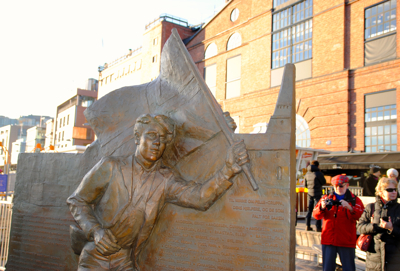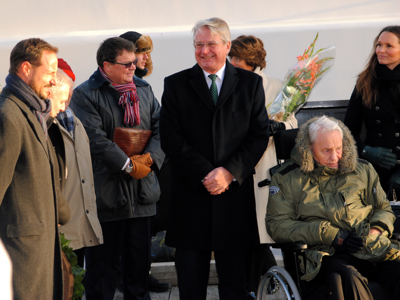After being all but ignored for more than 70 years, members of Norway’s World War II resistance movement known as “Pelle-gruppa” (the Pelle Group) finally won official recognition on Friday. Crown Prince Haakon joined in the unveiling of a statue honouring the Norwegian patriots who carried out critical sabotage operations against German occupiers at what’s now Oslo’s fashionable Aker Brygge waterfront complex.

The group was responsible for sinking several ships berthed off what then was the Norwegian shipyard Akers Mekaniske Verksted. Led by a brave resistance fighter named Ragnar Sollie, who used the code name “Pelle,” the group carried out a total of 16 sabotage operations between August 1944 and January 1945.
Sollie, however, was a member of Norway’s communist party during the war and maintained his communist political outlook after the war as well. Although he never linked the resistance group he led to the party, both he and its members were largely overlooked when the Germans surrendered and Norway’s government and royal family in exile returned home. Communist links were not popular during the Cold War that followed World War II, and Norway’s Labour Party began its decades of dominance of Norwegian politics. Other resistance groups and heroes like Max Manus, Gunnar Sønsteby and Jens Christian Hauge won most of the glory, and powerful positions in society as well.
Sollie died in 1987 and it wasn’t until a highly popular film about Max Manus came out a few years ago, and a statue raised in Manus’ honour, that calls increased for some recognition for Pelle-gruppa as well. Much of it was fueled by debate over where the new Max Manus statue should be located. Some wanted to place it at Aker Brygge, but war historians pointed out that would be wrong. The Pelle Group was behind the decisive resistance efforts there, while Max Manus and his colleagues operated on the other side of the harbour and elsewhere.

It ended with Max Manus’ statue being placed on the grounds of the Akershus Fortress, overlooking the site of his famed sabotage actions. Calls increased for a statue for the Pelle Group, too, ending with the statue unveiled Friday in brilliant sunshine and with the royal recognition that had been absent for so long.
The statue, created by sculptor Kirsten Kokkin at a cost of NOK 1.2 million, was financed by the City of Oslo and Samlerhuset, the official distributor of memorial coins and medals in Norway. Samlerhuset also financed the Max Manus statue, and agreed to support the Pelle project when asked.
“Like many others, we didn’t know much about the Pelle group,” Samlerhuset leader Ole Bjørn Fausa told newspaper Aftenposten. “We read up on it and became concerned over the lack of recognition they had received. So we decided to say ‘yes.'”

Fausa noted that there are only two surviving members of the Pelle Group, Sverre Kokkin and Reidar Formo, and both were present at the ceremonies on Friday. “It was important to get the statue finished so that the two surviving members could experience it,” Fausa said.
Sverre Kokkin himself cycled from Hønefoss to Oslo carrying dynamite to be used for the sinking of ships at the Akers Mek yard. Kokkin is the father of sculptor Kirsten Kokkin, who was contacted by city leaders who’d voted to recognize the Pelle Group and ask whether she’d take on the job.
“I’ve grown up with all the stories about the war,” Kirsten Kokkin told Aftenposten. “So this statue is the sum of all those stories.” She took on the project, finished it in 18 months and it features young men on bicycles and running with banners and weapons, while a woman carries of pouch of newspapers that were illegal to print at the time. The 63 persons named on the memorial were Pelle-gruppa’s known saboteurs, the group’s main supporters and those killed during resistance operations.
A thousand persons were invited to a ceremony at City Hall before the statue was unveiled at Aker Brygge not far away. Thousands more pass by the spot every day, and Kirsten Kokkin told newspaper Dagsavisen she thinks the Pelle Group will now finally get at least some of the attention it has deserved. “But I do still think they should have had a greater place in Norway’s wartime history,” she said.
newsinenglish.no/Nina Berglund

